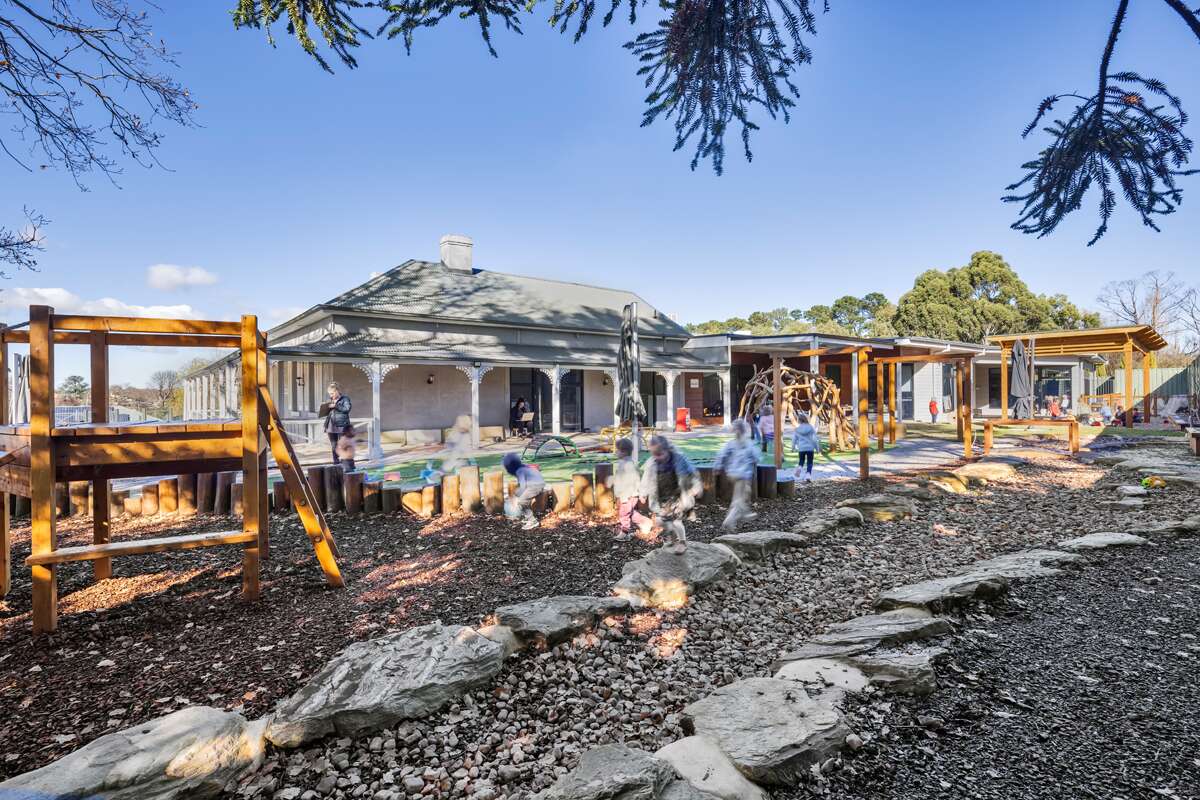Gardiner Architects designed the Mount Barker Childcare Centre in the Adelaide Hills, home to some of Australia’s best food, wine, and scenery.
It is situated on a large site surrounded by established gums.
The site has interesting parameters including a busy main road to the east, a reasonable slope across the property, as well as a heritage building to be retained and extended to allow for its adaptive reuse.
Early on in the initial phases of the project, the Gardiner Architects design team concluded that they wanted to allow the heritage house to be emphasized as the primary architectural expression, with the new addition subtly tucked behind.
The range of facilities required meant there was quite a large building mass to strategically locate.
Fortunately the size of the site allowed for the orientation of the building to be opened to both the north and south, allowing views into the adjacent outdoor play spaces and larger trees beyond.
The Gardiner Architects team visited the center after completion.
The spaces they’d designed were full of life and activity.
The large outdoor play space was all action with children engaging with the different play elements, with the large deciduous trees forming a dramatic feature hanging above the play space.
The whole area feels separated and protected from the busy road and carpark.
Inside, the internal layout prioritises connectivity between spaces allowing for effective supervision and ease of movement between facilities for the staff and children.
The entry and reception are located within the same space as the dining area and open kitchen, an important central space that all the children visit to eat and engage in food education.
The dining area was also strategically placed to act at the same time as a widened corridor, the connection point between the heritage building and the new addition.
It has become the informal meeting point where children and staff intermingle on their journeys throughout the day.
The visibility from the entry and reception also allows parents popping in to be connected and exposed to the children’s activities.
The corridors were designed by the Gardiner Architects team to allow a wash of light to filter into the spaces.
Rather than solely being a circulation space, the larger corridors become congregation areas where parents catch up and children meet before entering their rooms.
It feels like its own distinct area which provides variation in the spaces the children inhabit throughout the day.
Highlight windows above and views into a courtyard at the end of the corridor transform the circulation space into a visually interesting space that is easily activated and utilized with children’s artwork lining the walls.
The heritage building was in a state of disrepair and required some sensitive improvements to allow the building to be reused.
Gardner Architects prioritized retaining the period features internally while opening up the spaces to allow for adequate supervision and connection.
The size of the rooms allows for smaller, more intimate group activities.
The layout of the facility sees the older children in the heritage building with direct access to the large outdoor play space that holds more challenging equipment.
The younger children are in an area a distance away which allows a separation between more active, louder spaces and quieter areas for children that require naps during the day.
While the rooms were designed to open up to the surrounding outdoor play spaces, they can also be successfully shut down so whole rooms can be transformed into low-lit, quiet spaces conducive to transition times into rest.
A key design decision of the design team was locating the reception centrally rather than at the front, within the heritage building.
The movement of staff, parents, and children are far more efficient due to this.
Along with enhancing the efficiency of the building program by reducing circulation space, this also had the benefit of freeing up the whole heritage house to incorporate spaces for children.
The position of the entry and offices means that the Director, together with the administrative staff, can be directly associated with the daily activities of the teaching staff and children.
They too are a part of the children’s lives and can facilitate and respond to needs in a more engaged and connected way.
Overall, the Gardiner Architects’ layout allows the facility to be effectively moved through and supervised while the open nature of the spaces allows for a broad range of stimulating activities.
The design team was pleased to see an outcome that highlighted the heritage building as they always support the reuse of building stock rather than the disposal of useable building materials.
Project Details
Completion Date – 2021
Project Team
Architecture
Gardiner Architects
Gardiner Architects is an established practice of six architects and ancillary staff.
Founded over 30 years ago by director Paul Gardiner, the practice seeks to create thoughtful and honest architecture that is sustainable and well-made.
Photography
Aaron Citti
Aaron Citti is an award-winning commercial photographer based in Adelaide, Australia. He is an Associate of the Australian Institute of Professional Photography (AIPP) and specializes in professional commercial, architecture, and interior photography.
His work includes commercial and architecture projects in Australia and overseas, with many of his works published nationally and internationally in London, New York, Indonesia, Fiji, and New Zealand.
Photo Gallery
Click on a thumbnail image to enlarge it.
Design © 2022 Gardiner Architects. All Rights Reserved.| Images © 2022 Aaron Citti. All Rights Reserved.
The Builtworks Quest
At Builtworks, we’re on a multi-year quest to document, showcase, and spotlight the best of Australia’s built environment.
That’s why we’re creating this comprehensive online archive and educational resource that showcases a diverse and eclectic range of project types and scales.
Together with showcasing older exemplars of enduring merit, we spotlight and celebrate new and recent additions to Australia’s built environment.

